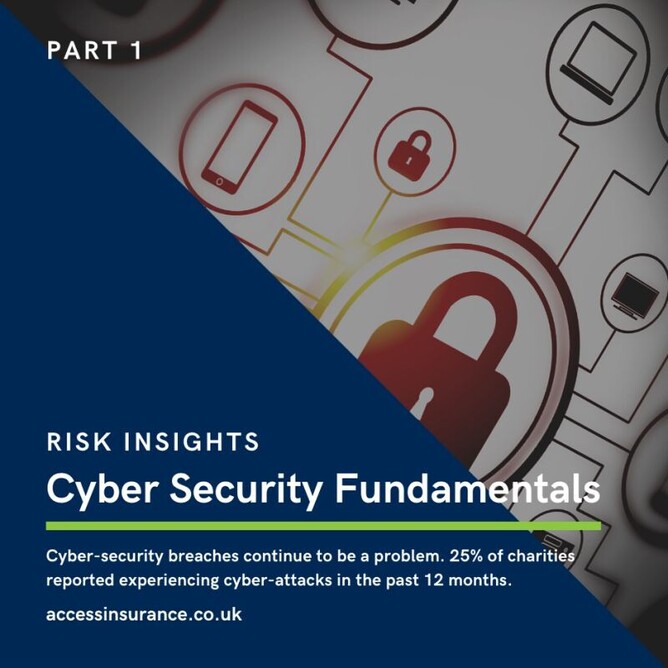Overview
Cyber-security breaches continue to be a problem for all types of organisations. According to a survey by the Department for Digital, Culture, Media & Sport, four in 10 businesses and a quarter of charities reported experiencing cyber-attacks in the past 12 months.
While organisations are always at risk from a cyber-attack, there may be a heightened risk at certain times. Broader problems—such as hacktivism and geopolitical tensions—can increase the cyber-risk organisations face. One such risk is the currently observed pattern of malicious Russian behaviour in cyber-space.
Organisations are being urged to boost their defences against potential cyber-attacks linked to tensions between Russia and Ukraine. Regardless of risk, it’s always wise to adhere closely to a cyber-strategy. This week we will go through some cyber-security fundamentals.
Defences and Updates
Keep systems and cyber-defences up-to-date.
1. Check Your System Patching
System patching is essential to correct errors in software that could lead to vulnerabilities if not fixed. Make sure you patch the following:
•Users’ desktops, laptops and mobile devices (If possible, turn on automatic updates.)
•Firmware on your organisation’s devices
•Internet-facing services
Additionally, review any unpatched systems. Ideally, all key business systems should be patched. If this isn’t practical, put mitigations for any remaining unpatched systems in place.
2. Check Your Defences
Bolster your defences by ensuring antivirus software is installed correctly and active on all systems.
Review all firewall rules regularly. These determine the network traffic allowed to enter and exit your network. Often temporary firewall rules are set up to enable a contractor or similar to perform a task for a particular timeframe. If such rules are left in place for longer than required, security risk increases.
Additionally, check the security defences of all other devices such as laptops and mobile phones. Consider the National Cyber Security Centre’s device security guidance.
Access Management
Access management is the process of identifying, tracking and managing users’ access to any IT applications or systems. Increase your access management resilience through the following methods:
1. Bolster password security—Ask staff to ensure passwords are unique to the organisation and not re-used at home. Educate users to create strong and unique passwords with a mixture of letters, numbers and characters.
2. Review accounts—Carefully review any accounts with privileged or administrative access. The fewer people with access to sensitive information, the better, so manage the number of privileged accounts and swiftly remove old or unused accounts.
3. Review multi-factor authentication (MFA)—If you have MFA enabled, check it’s properly configured.
4. Check third-party access—If third-party organisations have access to your IT networks, make sure you thoroughly understand what level of privilege they have and take time to review any third-party security practices. Remove any third-party access that’s no longer required.
Logging and Monitoring
1. Check security logs
Logging is the practice of managing the log data produced by your applications and infrastructure. Determine what logging you have in place, where logs are stored and how long logs are retained.
Security monitoring is vital for the identification and detection of threats to your IT systems. Review your logs—especially antivirus logs—regularly to search for errors, anomalies or suspicious activity. Where possible, keep your logs for at least one month.
2. Check your internet footprint
Check your external internet-facing footprint is up to date. This includes checking which IP addresses your system uses and which domain names belong to you. Check that your password is secure on any domain registration account.
3. Consider performing a vulnerability scan to check that everything you need to patch has been patched. Better still, make this a part of a wider organisational Vulnerability Management Plan (https://www.ncsc.gov.uk/guidance/vulnerability-management).
4. Review your incident response plan to ensure escalation routes and contact details are up to date. Make sure your policy states who has the authority to make critical decisions and covers the procedure for any out-of-hours response. Additionally, consider how your incident response plan will be made available if your business systems are no longer functioning during an attack.
Review Backups
Check that your backups are working to ensure your data is safe and secure in the event of a cyber-attack:
1.Perform test restorations—Test currently saved data by restoring a small number of files/folders to a machine to confirm that your backups are running as planned.
2. Consider a cold backup—A backup taking place when the database is offline and not accessible to update is known as a cold backup. This method ensures the backup remains unaffected should any incident impact your live environment.
3. Extend your backup—Don’t just back up data. Ensure machine state and any critical external credentials (such as private keys and access tokens) are backed up too.
Training
Educate staff on the different types of cyber-attack. One such attack is phishing. According to Symantec, one in every 3,722 emails in the UK is a phishing attempt. Therefore, it’s vital to ensure you have a process in place to deal with any reported phishing emails.
Furthermore, ensure that your staff are made aware of any heightened cyber-risk. Getting buy-in from employees is crucial to help facilitate the adherence to the cyber-security strategy. Also, make sure everyone knows how to report suspected security breaches quickly.
Cyber Insurance
Another issue to consider in protecting your organisation against cyber-attacks is considering insurance that could help cover the costs that may arise if you suffer from a data breach or cybercrime.
Costs may arise through:
•Financial damage
•Reputational damage
As a result of a data leak, breach or other cybercrime.
To find out how CSCBG in partnership with Access Insurance can help your organisation protect itself against cyber attacks contact us at buy@cscbg.org.uk
https://www.cscbg.org.uk/page/access-insurance/
EasiPC our preferred IT supplier has ‘Cyber Essentials Plus’ certification and are therefore well equipped to deal with the Technical aspects of ensuring your organisation is Cyber secure.
EasiPC are committed to keeping Cyber Security at the front of everything they do, and they are able to bring their ever-increasing knowledge in this area, to our customers to keep them as safe as possible with the ever-growing threat of exploitation.
To find out more about how EasiPC in partnership can help to make your organisation Cyber Secure contact us at buy@cscbg.org.uk
https://www.cscbg.org.uk/easipc/



